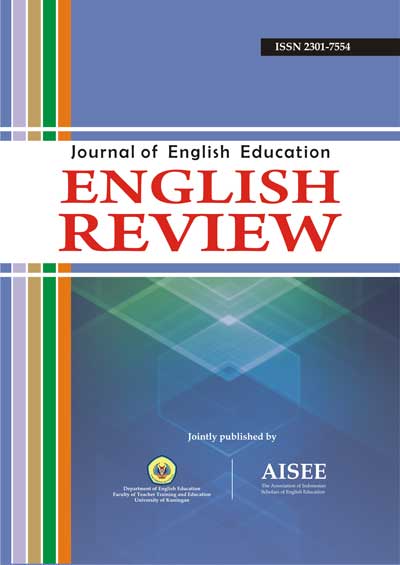ENDORSING REFLECTIVE TECHNIQUES TO PROLIFERATE STUDENTS’ INTERACTIONS AND UTTERANCES IN A DISCUSSION FORUM
Abstract
Abstract: High Intermediate-2 students’ brief responses in a discussion forum cause a long-expected discussion last in a couple of minutes in mixed-ability classes, depicting a minority of students are overtly dominant, while others are precisely passive. What yields discussions endure immaturely stems from both unclear roles of participants and their inadequate techniques to expand both interactions and spoken discourse. Therefore, Teacher-researcher assigned each participant in a discussion group of three to put reflection into practice, referring to the self-selected and discussed topics. The data were gained through non-participant observations, in which the teacher-researcher observed and recorded a singled-out group. A sample recording was, subsequently, transcribed and analyzed regarding with the number of exchanges in a ï¬ve-minute discussion intake and the number of content words that students generated. It was found that employing reflective techniques, students were able to keep a particular topic being discussed at full. As a result, the number of content words multiplied. These ï¬ndings resulted classroom teachers in insightful use of reflective techniques as one of the ways to proliferate students’ beneï¬ts in a discussion forum. Adequately practiced, students would be able to employ the techniques preponderantly, multiplying interactions among discussion members.
Keywords: reflective techniques, students’ interactions, utterances, discussion forum.
References
Allwright, D. And K.M. Bailey. (1991). Focus on the language classroom: An introduction to classroom research for language teacher. Cambridge: Cambridge University Press.
Chaudron, C. (1988). Second language classroom research: Research on teaching and learning. cambridge: Cambridge University Press.
Finegan, E., Blair, D. and Collins, P. (1992). Language: Its structure and use. Sydney: Harcourt Australia Pty Limited.
Jhonson, K.E. (1995). Understanding communication in second language classroom. Cambridge: Cambridge University Press.
Krashen, S. D. (1982). Principles and practices in second language acquisition. Oxford: Pergamon Press.
LIA. (1998). Conversation-3 Book. Jakarta: LBPP LIA
___. (2007). Conversation-3 Book. Jakarta: LBPP LIA
Moritoshi, P. (2001). Teacher questioning, modification and feedback behaviors and their implication for learner production: an action research. Retrieved October 27, 2010 from http://www.cels.bham.ac.uk/resourches/essays/Moritoshi 1.PDF..
Sinclair, J. Mch. And R.M. Coulthard. (1975). Towards an analysis of discourse. Oxford: Oxford University Press.
Swain, M. (1985). Communicative competence: some roles of comprehensible input and
comprehensible output in its development, in Gass and Madden: 235 – 53
Thompson, G. (1997). Training teachers to ask questions. ELT Journal, 51(2), 99-10.Thornbury, S. 2002. How to teach vocabulary. London: Longman
Walsh, S. (2001). Charaterizing teacher talk in the second language classroom: A process
approach of reflective practice. Unpublished Ph.D. thesis. Queen’s University of Belfast,
Northern Ireland.
Van Lier, L. (1988). The classroom and the language learner. London: Longman.
All articles published in English Review: Journal of English Education (ERJEE) are licensed under the Creative Commons Attribution 4.0 International License (CC BY 4.0).
Copyright Ownership
Authors retain the copyright of their articles and grant ERJEE the right of first publication. The journal is granted a non-exclusive license to publish, reproduce, and distribute the article in any format, medium, or platform, provided that proper credit is given to the original authors.
License Terms – CC BY 4.0
Under the Creative Commons Attribution 4.0 International License, others are free to:
- Share — copy and redistribute the material in any medium or format
- Adapt — remix, transform, and build upon the material for any purpose, even commercially
As long as they:
- Provide appropriate credit to the original author(s) and source
- Provide a link to the license (https://creativecommons.org/licenses/by/4.0/)
- Indicate if any changes were made
There are no restrictions on the reuse, reproduction, or adaptation of published articles as long as attribution is properly given.
Author Warranties
By submitting a manuscript to ERJEE, authors confirm that:
- The work is original and does not infringe any existing copyright.
- The manuscript has not been previously published and is not under consideration elsewhere.
- All sources and references are appropriately acknowledged.
- Necessary permissions have been obtained for any copyrighted materials used.










